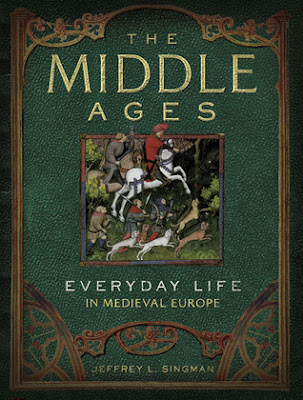The Middle Ages: Everyday Life In Medieval Europe – Jeffrey L. Singman
We consider the Middle Ages barbaric, yet the period furnished some of our most enduring icons, including King Arthur's Round Table, knights in shining armor, and the idealized noblewoman. In this vivid history of the time, the medieval world comes to life in all its rich daily experience. Find out what people's beds were like, how often they washed, what they wore, what they cooked, how they worked, how they entertained themselves, how they wed, and what life was like in a medieval village, castle, or monastery. Contemporary artworks and documents further illuminate this fascinating historical era.
Review: This book does exactly what it says on
the cover. It’s divided into chapters (“Village Life,” “Castle Life,” “Monastic
Life,” “Town Life”). Each chapter explains what daily life was like for people
in these environments. The book includes photographs of artwork and
architecture that was made during medieval times.
I took a European history class and a
German history class in high school, but other than that, I don’t know much
about the middle ages. This book
provides a good introduction to the time period for people like me.
The
Middle Ages: Everyday Life In Medieval Europe lives
in that weird gray area of educational books. It doesn’t go deep enough into any subject to be useful for serious
academic research, but it’s too textbookish for casual reading. There were
a few times where I felt my eyes glazing over with boredom while reading.
(Spoiler alert: medieval taxes were just as dull as modern taxes.) The book has a lot of pictures, but I
actually think it could have used more. In history books, a picture is worth a thousand words. For me,
drawings and diagrams would have been more useful than long descriptions of
clothing and buildings.
I
did learn a lot, though, so the book is worth reading.
**Some
fun facts about everyday life in medieval Europe**
1. Apprentices often ran away. There were
laws about how many days an apprentice’s boss and parents had to spend looking
for him if he ran away from his job.
2. Manufacturing was hard and expensive.
Medieval people didn’t own many clothes or household items. Rich people who
owned multiple houses didn’t furnish every house. When they moved from one
house to another, they dragged all their stuff with them. Old or broken items
were recycled and made into something new.
3. Part of a doctor’s job was to taste the
patients’ pee to see if it tasted healthy. The book neglects to explain what
healthy pee tastes like.
4. The diet of medieval peasants was more
nutritious than the diet of modern Americans. Medieval people also had more
time off work than modern Americans. They did have to deal with famines and widespread
disease, though.
5. Forks and plates didn’t really exist.
People ate with knives, spoons, and fingers. They used slices of bread as
plates. Rich people gave their bread-plates to the poor or to the servants
after they ate all the good food off them. That’s kind of disgusting, but I
guess it’s better than starving to death.
6. Tourism existed. Rich people made
pilgrimages to holy sites and bought souvenirs.
7. College students have always been idiots.
One university was shut down for two years after a series of violent clashes
between angry townspeople and drunken students.
Despite being dull in places, I learned
enough from The Middle Ages that I
want to find the other books in the Everyday Life series. I think the others
are about ancient Greeks, ancient Egyptians, and Vikings. I’m looking forward
to them.


This sounds like a book I would've been fascinated by as a teenager. I was so obsessed with this time period! I can definitely see how this book could be boring in places, but I'm glad it was interesting overall. Fact number three though... wow. Great review :D
ReplyDeleteTracy @ Cornerfolds
Yeah, fact 3 . . . yuck.
DeleteAj @ Read All The Things!
It sounds interested enough but I think it would be to dull for me. I do like the tidbits you learned though. Great review!
ReplyDeleteThe super awesome thing about reading educational material is an adult is that you can skim or skip the boring parts, knowing nobody is going to test you on them!
ReplyDeleteIn college, one book that made a big impression on me was Montaillou, which was about a 14th century French village that got investigated for heresy, and how the records from the inquisition provide a really rich view of what life was like in that time and place.
I love the facts that you listed. I am still trying to imagine a bread plate. I guess their bread would be a little firmer than a loaf of wonder so it would work. This one sounds really interesting. Great review!
ReplyDeleteBasically laughing so hard I am crying right now- "The book neglects to explain what healthy pee tastes like." BWHAHAH. I also am pretty sure I attended one of those colleges ;) Seriously though, I want to read this just because..., well, frankly, I probably wouldn't pass up the chance to actually READ a history textbook? I love history. But I also would want to know the answer to the pee question. How long is this bad boy anyway? I mean, I am looking it up on Goodreads of course. Huh, only 328, I could do this! I just might! Thanks for the heads up, I never would have known this existed! Great review, you made me chuckle :D
ReplyDelete